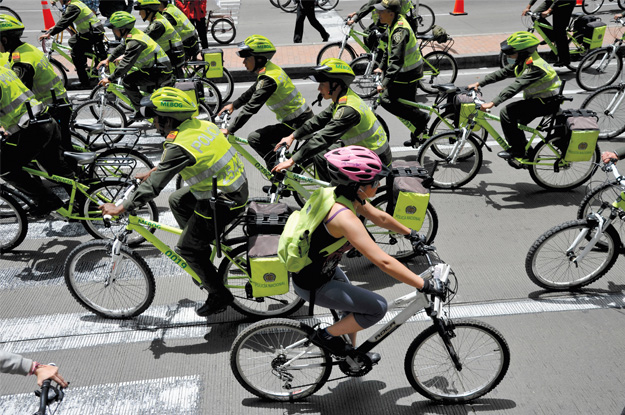This article is adapted from AQ’s print issue on how to make Latin American cities better | Leer en español
We live in a world where there are still over 1.5 billion people without electricity; just under 1 billion don’t have safe drinking water; and over 2.5 billion can’t access basic sanitation. A stunning $59 trillion in infrastructure investment — the equivalent of 30 times Brazil’s annual economic output — will be needed globally over the next 15 years to keep up with population growth, replace aging facilities, and meet economic development standards, according to Citi GPS: Global Perspectives & Solutions, Citi’s research arm. Given that a majority of the world’s population lives in cities, urban areas will have the greatest investment need. Our cities’ crumbling infrastructure comes at a real cost for citizens and the economies we live in.
In Latin America, there have been many scalable urban innovations, particularly in transport, that have spread across the world. Yet there is still a huge financing need to maintain and expand urban infrastructure. So why aren’t investments in sustainable urban solutions happening faster and at greater scale?
We have found that the problem is generally not one of either supply or demand: Investment capital and city demand for sustainable solutions are both strong. The challenge is that the supply and demand are often mismatched: Cities’ sustainable infrastructure projects (the demand side) are often not seen as viable investment opportunities by the investor community (the supply side) because such projects are often perceived as too small or too risky to invest in, relative to the potential expected returns. Furthermore, structuring successful sustainable projects can be a complex, time-consuming process, as each one tends to be unique.
Take electric buses, for instance. While electric buses cost less to operate (less fuel and lower maintenance are required), their upfront purchase price is over 50 percent more than traditional buses, and being a relatively new technology, there remain some uncertainties around their infrastructure needs, technology options, and performance in the long run. So despite the many environmental benefits and savings that electric buses promise over time, many cities remain hesitant to make the switch from diesel buses. This is only one example of the type of mismatch that results in too few “bankable” projects, or investment-ready projects that are attractive enough for investors.
Underlying the gap between supply and demand are three related factors:
1. Sustainable projects, like electric buses, often involve novel, nontraditional infrastructure assets and therefore have different, sometimes riskier, investment profiles.
2. Key stakeholders are not familiar with alternative infrastructure and service solutions, and there is little opportunity for such actors to learn about new models or have an open dialogue with peers from other cities about which solution worked best for them and why.
3. Investment environments in emerging markets, especially policy and regulatory frameworks, have not yet adapted to sustainable approaches.
To help close the finance gap and get projects off the ground, coalitions such as the Sustainable Development Investment Partnership (SDIP), helmed by the World Economic Forum and Organization for Economic Co-operation, are promoting the use of blended finance in sustainable investments in developing countries. A membership coalition, of which Citi is a member, consisting of government, private sector and the civil sector, SDIP brings together leading institutions engaged in using public or philanthropic dollars to spur private-sector investment in projects. Despite such efforts, the pace and scale of sustainable infrastructure still lags behind what is needed to meet the 2030 targets of the Sustainable Development Goals (SDGs).
That is why the Citi Foundation launched the Financing Sustainable Cities Initiative (FSCI), a unique partnership between the C40 Cities Climate Leadership Group, a network of cities focused on addressing climate change, and the World Resources Institute’s (WRI) Ross Center for Sustainable Cities, that aims to address each of the aforementioned challenges and bridge the gap between ideas and implementation. As part of the initiative, WRI and C40 work directly with local governments to help cities advance their projects through workshops on innovative financing options and one-on-one support throughout the implementation process.
By identifying what makes successful sustainable urban projects around the world work, this partnership is helping city governments learn from one another to develop action plans that quickly advance projects — from bike-sharing systems to energy-efficient buildings.
Additionally, the FSCI hosts an online platform with case studies and interactive tools to help cities begin designing their own projects and figure out how to pay for them.
Across Latin America, the FSCI has supported numerous cities, including providing advisory services to Bogotá, Colombia, in developing its bike-sharing system, and helping Cali, Colombia, in its pursuit of the country’s first transit-oriented development project in the city’s Green Corridor. In Santiago, Chile, the biggest challenge for Transantiago’s transition to electric buses was the lack of trust operators had in this new technology and the higher upfront investment. The FSCI helped acquire the first electric buses in the city’s fleet by conducting a workshop with key players and helping them explore finance options.
In Mexico City, an FSCI workshop with city officials and energy-efficient technology providers revealed that municipal budgeting and public procurement regulations were key constraints to deploying efficient building technology, as existing procedures make it tricky to engage in the long-term contracts that are best used for these technologies. Bringing these stakeholders together and facilitating this dialogue was an important step in acknowledging this challenge and, ultimately, taking the necessary steps to accelerate local government implementation of building efficiency policies. Globally, over the last two years, the initiative has supported more than 100 cities in advancing clean energy and transportation projects.
As cities across the region grow, however, the resources they will require go beyond financial investment. While infrastructure investment is a critical component of meeting the SDGs by 2030, there are several key goals that lead us to consider the many facets that make cities better places to live. We can’t forget that cities are not just made of bricks and mortar, but also people — and when investments of this scale and scope are made, they should be done in the interest of serving residents’ needs and improving their quality of life. Organizations like the Institute for Transportation and Development Policy (ITDP) are doing just that, advising city governments on how to make cities safer, more livable and more equitable.
In Brazil, ITDP built an alliance with the São Paulo mayor’s office to implement street design improvements in the form of reduced speed zones. Through this partnership, ITDP, using innovative street design elements, transformed intersections in three of São Paulo’s highest traffic neighborhoods into Zone 40s (reduced speed zones) to model the community impact safe pedestrian zones can have within cities.However, this was more than a bilateral partnership between ITDP and the government. ITDP, using a grassroots approach, worked side-by-side with community residents to understand their needs and challenges and partnered closely with them to design spaces that allow the community to thrive. The partnership has been so successful that, with the guidance of ITDP, São Paulo is working to further replicate the Zone 40 model in 10 other neighborhoods and transform the current temporary intersection redesigns into permanent zones in 2018. ITDP is also already in the process of replicating the program in other cities across Brazil.
The reality remains, however, that the need for sustainable development is outpacing our urban solutions. The good news is that this urgency is helping shift the risk perception and it’s increasingly clearer that innovation carries a much smaller price tag than doing nothing at all. There is also a return on innovation; not just avoided costs. In fact, studies show that investing in sustainable solutions could generate significant economic growth through new market opportunities. Further, the growing number of cities moving from ideation to implementation means that both policymakers and financiers have data and experience that can increase the rate of replication and success. This will only happen if we continue to share what works and, perhaps more importantly, what doesn’t work, so we don’t waste time on the race to a healthier planet and the path to sustainable urban growth.






